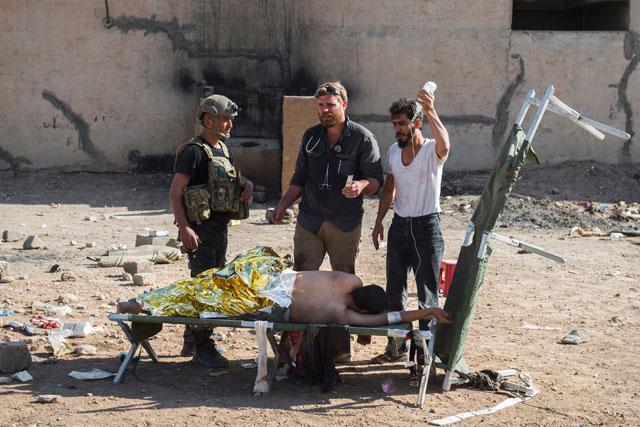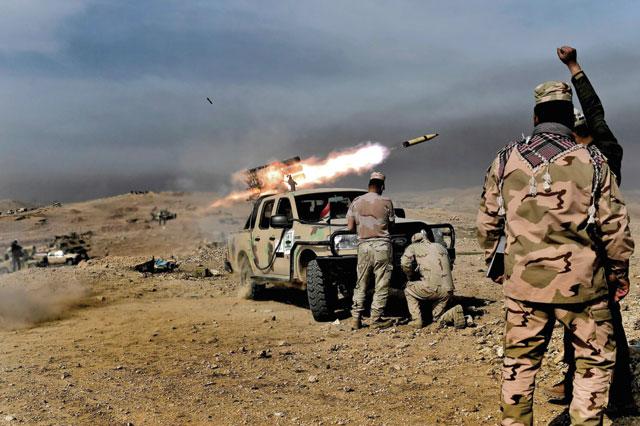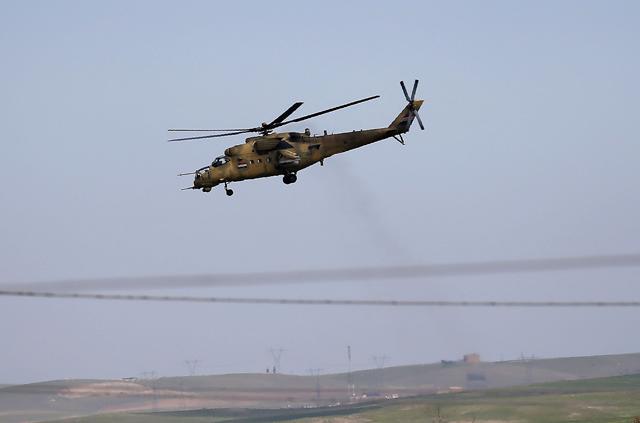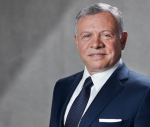You are here
1 month in, Iraq still faces grueling urban combat in Mosul
Nov 17,2016 - Last updated at Nov 17,2016

Army medics and volunteers attend to a patient suffering from injuries at an Iraqi Special Forces 2nd Division open air field clinic in the Samah neighbourhood of Mosul onThursday (AFP photo)
MOSUL — Layers of hastily erected barricades built from rubble and twisted metal trace Mosul's eastern frontline where Iraqi forces and Daesh extremists are facing off in the dense neighbourhoods and narrow alleyways of the country's second largest city.
As the operation to retake Mosul entered its second month on Thursday, Iraqi forces are preparing for prolonged, grueling urban combat.
They have slowed the tempo of their operations, advancing just a few hundred metres at a time.
But hundreds of thousands of civilians still remain in the city. And the ferocity and magnitude of Daesh counterattacks and defences in Mosul are unlike anything Iraqi forces have confronted in the fight against the militant group so far. As a result, overwhelming force can't bring swift victory and the campaign is likely to take weeks.
The eastern front Iraqi forces have advanced the furthest and faced the heaviest resistance in Mosul's east. Iraq's special forces say they control significant pockets of four of Mosul's easternmost neighbourhoods: Zahra, Qadisiya, Tahrir and Gogjali. The territory measures less than a tenth of the city's total area.
Inside those neighbourhoods, Iraqi forces are now surrounded by thousands of civilians as they continue to push to the city centre. The presence of civilians has already thwarted the use of overwhelming air power to clear territory.
Iraqi officers say they also worry that Daesh supporters among the civilians are helping the group.
"We control all of this area," Iraqi special forces Maj. Ahmed Mamouri said, speaking in the Zahra district. "We've cleared the territory of fighters, but some of the civilians still support Daesh," he said.
Mamouri said he believes Daesh supporters still living in this neighbourhood are acting as spotters to aim mortar attacks and scout targets for suicide bombers. That forces his men to not only focus on the frontline fight, but also look backward and repeatedly screen the thousands living among his men's positions, supply lines and defences.
When Daesh initially swept into Mosul in 2014 the group was met with significant popular support from residents, who are overwhelmingly from the Sunni Muslim minority that has long resented marginalisation by the Shiite-dominated central government. That support has eroded under more than two years of harsh militant rule and dire living conditions, Iraqi and coalition officials believe.
A complex, bloody
fight ahead
Over the past year, Iraqi forces have slowly clawed back territory from Daesh. Facing a militant organisation that proclaimed itself a state, Iraq’s security forces battled Daesh with conventional military tactics: cutting supply lines, besieging cities and measuring victory in square kilometres.
In Mosul, Iraqi forces are undertaking a much more complex fight.
Mosul is not yet surrounded by Iraqi forces and has smuggling routes and supply lines with Daesh territory in Syria. Iraq has mobilised some 100,000 troops from the military, as well as tribal and militia fighters, to take on the estimated 5,000 Daesh militants inside Mosul.
Also, the US-led coalition has deployed some 100 US troops to Iraqi front lines to help. The coalition has also launched more than 4,000 air strike the past month, mainly around Mosul, and provided Iraqi forces with surveillance and intelligence.
The individual tactics employed by Daesh mirror past fights: extensive tunnel systems, large, armoured car bombs, snipers and small units of fighters left behind to fight to the death.
But the sheer scale of Daesh defences and counterattacks in Mosul has stunned Iraq’s military.
During a single week, Iraqi special forces Lt. Col. Muhanad Al Tamimi said more than 30 car bombs attacked his troops on Mosul’s eastern edge. The US-led coalition estimates that since the operation was formally announced, coalition air strikes destroyed hundreds of metres of Daesh tunnel networks.
Humanitarian fallout
In past fights against Daesh in Ramadi and Fallujah, Iraqi ground forces emptied entire cities of their civilian populations, simplifying the battlefield.
In Mosul, a city more than five times the size of Ramadi, that’s not an option. Aid groups warn that the massive displacement of those still living in Mosul would overwhelm humanitarian organisations and the Iraqi government.
Iraqi commanders responded by telling people to stay in their homes and wait out the fight. But aid groups and government agencies cannot reach the thousands sheltering so close to the front line.
“We give them everything,” said Tamimi, who commands one of the divisions leading the Mosul advance. He says his men distribute extra food and water to civilians when they can, but eventually the government needs to step in.
Convoys of black armoured Humvees weave past small groups of civilians sitting on street corners and crowds lining up outside a handful of reopened shops. Hundreds of civilians also continue to flee daily from areas still under Daesh control, filing past front lines and holding white flags fashioned from scraps of fabric.
Southern and western advances
Iraqi forces to the south, north and west of the city are struggling to cut supply lines and tighten their hold on the city.
On the city’s southern approach, Iraqi forces advanced more than 40 kilometres over the past month, largely up the Tigris River valley. They are now preparing to launch an operation to retake Mosul’s airport on the city’s southern edge.
Over 60 kilometres west of Mosul, government-sanctioned Shiite militia forces are slowly working to surrounded the historically Turkmen town of Tal Afar, which sits on a key supply line linking Daesh-controlled territory in Iraq to the group’s holdings in Syria.
One family’s story
Since the operation began, more than 56,000 civilians around northern Iraq have been forced from their homes, according to the United Nations.
Inside Mosul, thousands remain in neighbourhoods retaken by government forces. But thousands more have been driven from their homes by the fighting.
Mahmoud and his family waited out weeks of air strikes and shelling in Mosul’s Qadisiya Al Thaniya neighbourhood. Loud explosions that shook the house and broke windows became commonplace. Early in the operation, an air strike destroyed a car bomb just two houses away.
“The shrapnel landed on the roof of our house and in the garden,” he said. He spoke on condition only his first name be used, fearing for the safety of family still in Daesh-held parts of Mosul.
When clashes broke out on his street, Mahmoud decided to pick up and move a few blocks away from the frontline with his wife, children and their grandparents. Everyone packed small bags and waited until the fighting subsided at dawn to flee. Then just minutes after leaving their home, Mahmoud’s father in law stepped on a booby-trapped explosive.
The blast killed him instantly. The rest of the family suffered shrapnel wounds. After the blast, Iraqi troops evacuated the entire family to a frontline field clinic on the city’s outskirts.
“I haven’t told my children yet that their grandfather is gone,” Mahmoud whispered, his eyes welling with tears.
From here, he said he was told his family would be taken to a camp for displaced civilians to wait until it’s safe to return.
“This war will be difficult,” he said, “I don’t expect to go home for at least a year.”
Related Articles
SOUTH OF MOSUL — Iraqi forces battling the Daesh terror group in west Mosul reached the city's southernmost bridge Monday, a key step in eff
BAGHDAD — Up to 100,000 children are in danger as Iraqi forces battle to retake west Mosul from the Daesh terror group, the United Nations c
ERBIL, Iraq — The Daesh terror group shot down an Iraqi helicopter operating over Mosul on Thursday, as security forces announced they recap

















